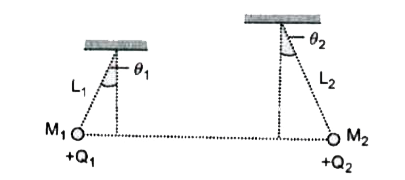The radiation emitted when an electron jumps from n=3 to n = 2 orbit in a hydrogen atom, falls on a metal to produce photoelectron. The electron with maximum kinetic energy are made to move perpendicular to a magnetic field of 1320 T in a radius of 10m. The work function of the metal is :Solution in Kannada
3.03 eV
2.03 eV
1.03 eV
0.03 eV
The correct Answer is:A
Wavelength of emitted radiation is given by
1λ=R(122)−132=5R36
Given r=10−3mandB=1320T
Now r=mveB=√2mkeB
Here K is K.E. of emitted electron
∴K=r2e2B22m
=10−6×(1.6×10−19)2×12×(9.1×10−31)2(320)2=10−178×9.1
=10−1772.8×1.6×10−19eV=0.86eV
Now hcλ=K+w
∴w=hcλ−K
=5Rhc36−K
=5×13.636eV=0.86eV
w=103.eV is work function of metal
Topper's Solved these Questions
- ELECTRONS & PHOTONSBOOK - MODERN PUBLICATIONCHAPTER - ELECTRONS & PHOTONSEXERCISE - MULTIPLE CHOICE QUESTIONS (LEVEL-III)
9 Videos
- ELECTRONS & PHOTONSBOOK - MODERN PUBLICATIONCHAPTER - ELECTRONS & PHOTONSEXERCISE - RECENT COMPETITIVE QUESTIONS
20 Videos
- ELECTRONS & PHOTONSBOOK - MODERN PUBLICATIONCHAPTER - ELECTRONS & PHOTONSEXERCISE - RECENT COMPETITIVE QUESTIONS
20 Videos
- ELECTROMAGNETIC WAVESBOOK - MODERN PUBLICATIONCHAPTER - ELECTROMAGNETIC WAVESEXERCISE - RECENT COMPETITIVE QUESTIONS
4 Videos
- ELECTROSTATICSBOOK - MODERN PUBLICATIONCHAPTER - ELECTROSTATICSEXERCISE - RECENT COMPETITIVE QUESTIONS
39 Videos
Similar Questions
Energy required for the electron excitation in Li++ from the first to the third Bohr orbit is :
View SolutionAccording to Einstein's photoelectric equation the graph of K.E. of the photoelectron emitted from the metal versus the frequency of the incident radiation gives a straight line graph whose slope
View SolutionAccording to Einstein's photoelectric equation the graph of K.E. of the photoelectron emitted from the metal versus the frequency of the incident radiation gives a straight line graph whose slope
View SolutionThe speed of electromagnetic wave in vacuum depends upon the source of radiation
View SolutionTwo small spheres of masses M1andM2 are suspended by weightless insulating threads of lengths L1andL2 The spheres carry charges Q1andq2 respectively . The spheres are suspended such that they are in level with one another and the threads are inclined to the vertical at angles of θ1andθ2 as shown . Which one o fthe following conditions , if θ1=θ2 ?

View SolutionThe rediation emitted when an electron jumps from n = 3 to n = 2 orbit in a hydrogen atom falls on a metal to produce photoelectron. The electron from the metal surface with maximum kinetic energy are made to move perpendicular to a magnetic field of (1//320) T in a radius of 10^(-3) m . Find (a) the kinetic energy of the electrons, (b) Work function of the metal , and (c) wavelength of radiation.
View SolutionWhen monochromatic radiation of intensity I falls on a metal surface, the number of photoelectrons and their maximum kinetic are N and T respectively. If the intensity of radiation is 2 I, the number of emitted electrons and their maximum kinetic energy are respectively.
View Solutionthe radiation emitted when an electron jumps from n=4 to n=3 in a lithium atom (z=3 ) fall on a metal surface to produce photoelectron , when the photoelectron with maximum Kinetic energy are made to move perpendicular to a magnetic field of 2×10−4T , it traces a circular path of radius √9.11.6cm, [RhC=13.6eV] (mass of electron=9.1×10−31kg)
View SolutionCalculate the energy and frequency of the radiation emitted when an electron jumps from n=3 to n=2 ina hydrogen atom.
View SolutionCalculate the energy and frequency of the radiation emitted when an electron jumps from n = 3 to n = 2 in a hydrogen atom
View SolutionWhen light of 2.5 eV falls on a metal surface, maximum kinetic energy of electron is T. If incident radiation of 4 eV falls on same metal surface, maximum kinetic energy of electrons is doubled. The work function of metal is
View SolutionRadiation corresponding to the transition n = 4 to n = 2 in hydrogen atoms falls on a certain metal( work function = 2.0 eV ). The maximum kinetic energy of the photoelectrons will be :
View SolutionDirection : The questions 57, 58 and 59 are based on following paragraph : Radiation emitted when an electron jumps from n = 3 to n=1 orbit in H2 atom, fall on a metal to produce photoelectrons. Electrons fall on the metal surface with maximum K.E. in a direction perpendicular to a magnetic field of 1/320 T in a radius of 10m−3.
The K.E. of the electrons is
View SolutionDirection : The questions 57, 58 and 59 are based on following paragraph : Radiation emitted when an electron jumps from n = 3 to n=1 orbit in H2 atom, fall on a metal to produce photoelectrons. Electrons fall on the metal surface with maximum K.E. in a direction perpendicular to a magnetic field of 1/320 T in a radius of 10m−3.
Work function of metal
View SolutionDirection : The questions 57, 58 and 59 are based on following paragraph : Radiation emitted when an electron jumps from n = 3 to n=1 orbit in H2 atom, fall on a metal to produce photoelectrons. Electrons fall on the metal surface with maximum K.E. in a direction perpendicular to a magnetic field of 1/320 T in a radius of 10m−3.
Wavelength of radiation is
View Solution
